M. Isidora Forrest's Blog, page 45
April 26, 2014
Making Offering to Isis
“Birth of Isis. Feast of ‘revealing the face’ of this Goddess with Her Ennead. Performing all the rites of the feast of robing . . . according to the ritual of the place of the First Feast. They make a great oblation of bread, beer, oxen, fowl, wine, milk, pomegranate-wine, [gazelles, oryx, ibexes], cranes, pigeons, fattened ducks, with fresh vegetables and all fruit. It is sweet to serve the Beautiful One with right offerings!”
—The Denderah Festival Calendar
This is how I have imagined making offering in the ancient temples of Isis…
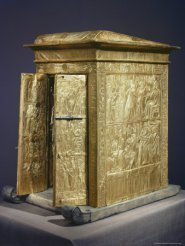
An Egyptian shrine
Each night, while I sleep, the light is withdrawn and a darkened world returns to primordial chaos. This disorder is Isfet, the opposite of Ma’et—Rightness, Truth. Like dark water, Isfet is of infinite, even frightening, possibility. Will it seep up moist like ground water, like dreams, to nourish growth and change? Or will it burst forth, unchecked, unsettling, and destructive? Anything might happen. Anything might exist out there in night’s shadowed darkness.
The formlessness of the unillumined world is why, each morning, I welcome with full heart the awakening of the Golden One. As She scatters Her gold dust across the world—bringing light, creating form—I release my breath to Her in relieved sighs. I am Her servant. I serve the Great Goddess Isis. “Ise” is how we whisper Her holy name. I am called the First of Those Who See Her for it is my privilege and duty to open Her shrine, unveil Her face, and make offering to Her each morning. I know better than most how sweet it is to serve the Beautiful One with right offerings.
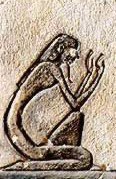
I honor Thee, Isis
While Isfet is still trembling at the edges of the world, I rise and make my purifications. My body, which will perform the ritual, is made pure with water. My mouth, which will speak the words of power, is made pure with natron. It is salty and, if I have much to purify, it sometimes makes me gag. When I am cleansed, I put on the white linen and white sandals and walk through the night-cooled corridors of the temple toward Her closed shrine.
The cooks, the bakers, the butchers have already been at work. They have prepared Her morning feast. The Pure Ones, the Wab priests and priestesses, have placed it in the Hall of Offerings and even now they chant for Her. The sistra of the priestesses rattle softly as I pass through the Hall of Offerings to finally stand before the closed doors of Her shrine.
Into the darkness before that sacred place, I speak the words that avert evil so that I may approach giving no offense and receiving no harm. I break the clay seal. I draw back the bolt, but I do not yet open the doors. For first I must offer incense to Her Eye, the fierce and fiery Serpent Goddess Who guards the Great One—and indeed Who is another of Isis’ kheperu, Her forms. When that Fierce One has taken Her pleasure and been pacified by the incense and the words of my mouth, I open the doors. Heaven and Earth open before me!

My living Isis image in Her temple shrine with flower offering
On my knees, I enter Her shrine, offering incense. The sweet smoke rises into the still air to encircle the Iset Weret, the Great Seat or Throne of the Goddess, Her innermost holy place. My heart remembers one of the Mysteries of my temple: that Isis is She Who is Upon Her Throne, and Who is also the Throne itself, for that is the very meaning of Her name. Isis is All Things; it is a great secret that I know as I prostrate myself before the Goddess Throne. I kiss the ground. My belly touches the Earth before Her. I speak the Adoration of the Goddess with all my heart. As they do every morning that I wear the white sandals to serve my Goddess, tears blur the vision of my eyes as I lift the Goddess’ veil to look upon Her beautiful face.
Isis is alive in Her sacred image. The Goddess is at home in Her temple. I can feel Her magic vibrate within the shrine. Her ka speaks to mine. I bid Her peace in awakening. In Her presence, I purify the food offerings with water and with incense. I name what we have prepared for Her. She smiles at me with golden lips.
I am now privileged to touch Her image. I take Her sacred body from the Great Throne into the shrine chamber. I wipe away yesterday’s unguent, She having received its ka. With the little finger of my right hand, with my gentle finger, I anoint the uraeus upon Her brow anew with Eye of Horus Oil. It makes Her limbs whole. It destroys evil like the strong talons of Her falcon child.
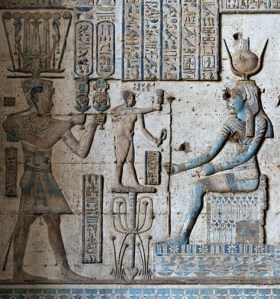
The king making offering to Isis, from Denderah
I remove the linen cloths placed upon Her image the day before. They will be taken away and washed. With Her unclothed image before me, I adore Her four times. I feel tender toward the Goddess Whose body I touch. I speak only truth before Her. My adorations are never rote. I speak heart-words to my Goddess. As I re-clothe Her in fresh linens—the white, the green, and the red—I purify with natron between each dressing. I purify again with water and incense. I circle Her image four times before returning it to its seat.
Once more upon Her Great Throne, Isis receives Her ornaments and implements of power. I place them upon Her body. I offer Her precious unguents, full of power. I take up pure sand and with ancient and holy words, I pour it out before Her. It grits beneath my white sandals as I enfold Her image first in the white head cloth, then in the Great Cloth. Now She is veiled once more in the protection of the Weaving Goddesses Who spin magic into linen.
Again I offer incense and circle Her living image four times. I take up the bundle of heden plants. As I back out of the shrine, I use them to sweep the sand clean, obliterating my footprints and returning the holy place to its primordial perfection. I close the doors, bolt them. Outside, I offer incense upon the brazier and circle the room four times, speaking protections.
By the time the rite is complete, the sun is high above the horizon. Day has come. Isfet is banished. The face of Isis shines like molten gold as She smiles upon Egypt. I am content.
—from the introduction to my Offering to Isis
Making offering is one of the most ancient and eternal ways we may interact with Isis. Do you make offering? If so, what do you do?
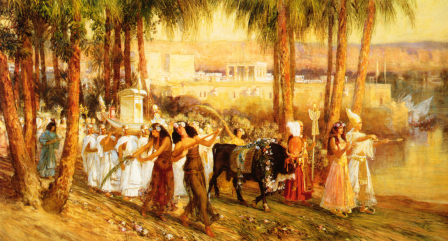
An Orientalist imagining of a procession for Isis, complete with Her shrine; art by Frederick Arthur Bridgman, mid 1800s
Filed under: Goddess Isis Tagged: Ancient Egypt, Egypt, Egyptian Temples, Goddess, Goddess Isis, Goddess worship, Isis, Isis Magic, Isis Rituals, Isis worship today, Making Offering, Offering in Egypt, offering to Isis








April 19, 2014
Isis & the Dark Night of the Soul

A depiction of the Dark Night of the Soul: Ce Que Je Suis by angelitonegro on Deviant Art
I read a short blog post the other day that made me sad…and sympathetic. It was by a young woman who felt she had lost the mystery of her Pagan path. The power of the rites had flown. She doubted. Her anguish was palpable in what she wrote.
This may have been the first time that had happened to her.
Yet I can guarantee that, if we follow any spiritual path for a sufficient length of time, this same thing will happen to each of us. At some point, the mystery dries up. The excitement dies down. The thrill of discovery is not as thrilling as it once was. Usually, this doesn’t happen all of a sudden and usually not in the early part of our journey with Isis. Rather, it’s a slow erosion that we don’t even notice. We just don’t feel like tending Her shrine or meditating or making offering today. We find we have other things to do. Practice slips away. That wonderful sense of Isis being with us in every step of our lives slips away. But we hardly notice.
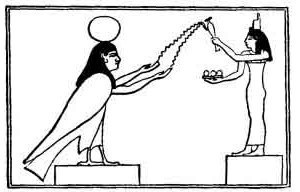
Isis giving sustenance to the ba in the Otherworld
Until we do. Notice, that is. Then, we might panic a bit. Especially if we have chosen a priest/essly relationship with Isis. O my Goddess, O my Goddess, O my Goddess! What happened? Where is She? What have I (not!) done?
If we’re not careful—and forget to breathe—thoughts and feelings can quickly escalate from there. Why am I even doing this? What if it’s all a lie? Where is She? Where is She? Where is She? We ask questions, but get no answers. It isn’t like it was before. We don’t seem to be who we were before, either. We may feel like strangers to ourselves just as we feel like strangers to Isis. We feel alone, cut off from the Goddess, perhaps even cut off from other human beings and from other pleasures in our lives.
The first thing we must understand about such periods in the spiritual life is that, though we feel desperately alone, we are not. Spiritual people throughout the ages have had this experience. Prehistoric shamans probably had it. There’s even a term for it, a term you probably know. It’s the “dark night of the soul,” which is the title of a poem and a treatise written by the 16th century Christian Mystic known as Saint John of the Cross. He writes of it as a necessary part of the soul’s journey to union with God. The phrase is so perfectly evocative that it has been adopted by many spiritual traditions today.
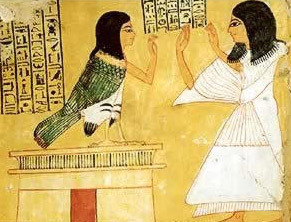
A man and his ba greeting each other
There’s even an ancient Egyptian precedent. It’s generally known as A Man Tired of Life in Dispute with His Soul (Ba) and is found in Berlin Papyrus 3024. The papyrus itself has no title. What we have left is the last part of the work; the first part is missing. In it, a scribe is arguing with his ba, trying to convince his ba to die with him. The man berates himself and declares the world around him to be a horrible place. The ba argues that the scribe should live and die only when it truly is his time. Egyptologists consider the papyrus very obscure and difficult. As a result, there are many different translations of the papyrus and they differ widely in their interpretation.
We do not know the purpose of the papyrus or the period to which it is dated. Most scholars put it in the First Intermediate Period, a time of confusion between the Old and Middle Kingdoms. Some have theorized that the author’s despair is a reflection of the chaos of that Intermediate Period. Bika Reed, who is of the Schwaller de Lubicz school of Egyptology, has interpreted it as an initiatic text, essentially dealing with the dark night of the soul.
We don’t know for sure, but the point is, this happens—and it has always happened. But what do we do when it happens?
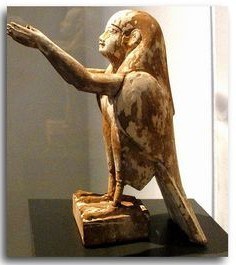
A beautiful statue of a ba
Having just had a birthday, and feeling rather ancient of days, I can tell you that I have had more than one dark night of the ba in my life with Isis. I have learned that patience and persistence are the keys to survival (as they are in so much of life). In these dark and dry places, we must be patient with ourselves and with the Goddess; we must persist in our practice. Even if we don’t feel anything happen when we meditate with Isis or when we place flowers upon Her altar, we must continue to do so. But we must also give ourselves a break. It’s okay if we don’t feel anything right now. It doesn’t mean Isis has abandoned us. It only means we are in a period of transition, even of initiation. Some consider a dark night to be part of the process of ego death that must precede a deeper relationship with the Divine, in our case, with Isis.
We may even give ourselves another type of break. If it had been our practice to meditate daily, perhaps we do so once every few days or once a week. That’s okay, too. The important thing is not to stop altogether, even if the sense of connection isn’t there. We just persist. Eventually—in a month, or even a year—something will change. The shell surrounding our hearts will crack. Like the Child Horus, our hearts will struggle out of the egg and be born. Eventually, we will return to our practice and find that it, too, is transformed. It is deeper, richer, juicier.
Held in Her wings, we are Becoming, even when we don’t know it.
Filed under: Goddess Isis, Modern Paganism Tagged: Ancient Egypt, Dark Night of the Soul, Egyptian magic, Goddess, Goddess Isis, Goddess worship, Isis, Isis Magic, Isis Rituals, Pagan spiritual crisis, Pagan Spirituality, Spiritual crisis, The Goddess








April 13, 2014
My Mother, My Heart
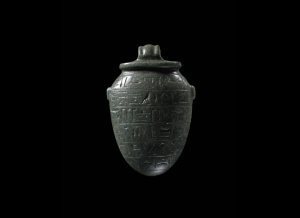
A heart amulet inscribed with magical text
When we say we are “thinking with our hearts,” we mean that we are being led by our emotions rather than our rational minds. The ancient Egyptians would have thought that we had it only partly right. They knew that they thought with their hearts all the time; it was, after all, the organ of thought. In the myth of Isis and Re, Isis was said to have pondered “in Her heart” how She could become more powerful and to have decided “in Her heart” how to do so. Of course, the heart was also the seat of emotions, but most importantly, it was the center of life itself. The heart was so important to the wholeness of the individual that it was the only organ not removed during mummification.
There are two main Egyptian words for “heart,” ib and hati. As it turns out, the relationship between ib and hati is much debated in Egyptological circles. Early in the history of Egyptology, the two terms were considered synonyms and both related to the physical heart. In the 1930s, Alexandre Piankoff argued that hati was the physical heart, while ib was the metaphorical one and described the emotions. Many examples exist that seem to go along with this idea. Having great fear could be described as “the heart not being in the body.” Being happy was “broadness of heart.” “To wash the heart” was to suppress a desire. Friends “entered into each other’s hearts.” “To immerse the heart” was to hide one’s thoughts. Yet not all examples of the use of ib are quite that clear. We sometimes find ib as a seemingly physical thing and we sometimes find hati as a seemingly metaphorical thing.
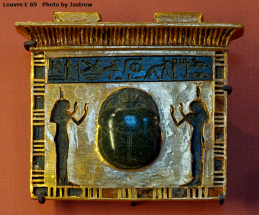
Isis and Nephthys guard the heart scarab that is given to the deceased.
In the Coffin Texts, the ib (as well as the belly) is a container for magic. Coffin Text 657 instructs the heart to “remember what is in you,” that is, magic. Other texts refer to “magic, which my ib sends out” or command magic to “come to this, my ib.” Knowledge also resides in the ib. In a more metaphorical vein, the hati can be “set against” someone. And in Coffin Text 75, the deceased says “Your hearts (hati) have spoken to me, You Gods.” A number of the texts, known as “heart spells,” often have the two terms in parallel, like Coffin Text 20:
There will be given to you your heart (ib) which you had from your mother, your heart (hati) which belongs to your body, your soul which was upon the earth, your corpse which was upon the ground.
The parallelism of the sentence might provide a clue. In the same way that soul is intangible and corpse is tangible, perhaps the “heart which you had from your mother” and “your heart which belongs to your body” are intangible and tangible concepts, too. Because both the ib and the hati will be given to the deceased, it is the totality of the heart, in both physical and spiritual aspects, that is required in the otherworld; both will be needed for rebirth.
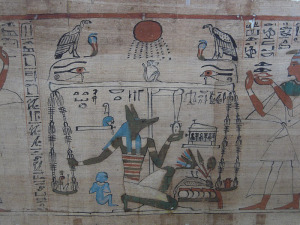
On one side of the balance, the heart, on the other the Feather of Truth; note the chains made of the Knot of Isis and the Djed of Osiris that uphold the pans of the balance.
Isis and Her sister Nephthys are among the foremost givers of hearts in these funerary texts. In the Pyramid Texts, Isis says, “I am Isis; I have come that I may lay hold of you and give you your heart for your body.” In the Coffin Texts, Isis and Horus reciprocally bring Their hearts to each other—and will do the same for the dead: “I bring for you your heart into your body even as Horus brought the heart of his mother, even as Isis brought the heart of her son Horus.” A similar passage comes from the daily rites of the temple of Amun Re. Isis is said to bring Horus His heart to “set its upon its seat.” Then Horus brings Isis Her heart to set it upon its seat. There was an Egyptian idiom, iset ib, that may shed some light. It literally means, “seat of the heart” and is equivalent to our “having set one’s heart upon” something. The iset ib is the heart’s desire. Were Isis and Horus giving each other Their heart’s desire?
Yet for Isis devotees, there is another interpretation of iset ib that I think is even more beautiful. In this case, the iset ib would be the Iset Ib: the “Isis Heart” or “Heart of Isis.” The Iset Ib is that inner core where our individual hearts touch the heart of the Great Goddess Isis. The Isis Heart is the intangible, spiritual “heart that I had from my Mother,” the Great Mother of us all, Isis. It is that piece of the Goddess that lives within all of us and through which we can access Her greater Divine Heart and Being.
Just as the ancient Egyptian dead needed their hearts, ib and hati, to be reborn, we, too, need our hati heart of our bodies to live and our ib heart to commune with the Divine. The Iset Ib is the ‘heart that I had from my Mother Isis’ and through it, we can discover Her at any time. We become still, we breathe, and we focus on our hati heart, the living muscle in our body, which is the physical heart, but also seems to have been more. As we relax and open the hati heart, we also open our ib heart. The physical becomes a gateway to the metaphysical. One heart opens another heart to commune with a Divine Heart. Isis speaks to both our hati and our ib hearts. And then She awakens our Iset Ib, our own Isis Heart, and we become “aware in my heart,” just as the Book of Coming Forth by Day says.

I am aware in my heart, the heart that I had from my Mother Isis
Filed under: Goddess Isis Tagged: Aspects of Isis, Egypt, Egyptian heart metaphors, Egyptian words for heart, Goddess, Goddess Isis, Iset Ib, Isis, Isis Magic, Isis worship today








April 6, 2014
Isis-Ma’at, Lady of Truth

Ma’at, the Goddess of Truth & Rightness, can be identified by the Feather of Truth upon Her head.
As I am sure you know, Ma’at is the Egyptian Goddess of Truth, Universal Order, and Right. The ideas related to Her form the very core of the ancient Egyptian conception of the way things should be. Ma’at was considered to be the very food of the Goddesses and Gods. Ma’at explained the relationships between humanity and the Divine. Ma’at was natural law and social law. Ma’at was not only justice, but also fairness and even kindness toward one another. Ideally, the king who ruled Egypt, the viziers who advised the king, the judges who made decisions that affected the people, and the people themselves all operated under the laws of Ma’at. If they did, peace and plenty and Divine favor would reign in the land.
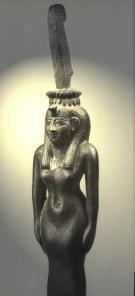
The curviest Ma’at I’ve ever seen
The quintessential symbol of Ma’at is the shut, the ostrich plume that represents the “lightness” and all-pervading, airy nature of Truth and Right. It is against the Feather of Truth that the heart of the deceased is weighed during the post mortum judgment before Osiris. The 42 Assessors Who witness the judgment each hold a Ma’at feather. Following a successful judgment, and as an attestation of her truthfulness, the deceased was sometimes shown wearing Ma’at feathers upon her head and suspended from her wrists and arms.
Isis, too, is associated with these ideals and sometimes Ma’at is assimilated with Isis. The Osirian Hall of Judgment is also known as the Hall of the Two Truths. Twin Goddesses, the Ma’ati (the Two Truths), presided over it. Very often, the Ma’ati were specifically identified as Isis and Nephthys. (As an aside, I have always found the idea of the Judgment Hall being the place of Two Truths to be a particularly wise concept; there are always at least two sides to any story and both are likely to be true—from the perspective of each participant.)
Without Her twin, Isis was identified with Ma’at’s singular form. The Coffin Texts tell us that Isis comes before the deceased as Ma’at. An inscription at Denderah says that Isis the Great is not only Mother of the God, but also Ma’at in Denderah. Plutarch records a tradition that points to an identification of Isis with Ma’at (“Justice”) in Hermopolis. He writes, “that is why they call the leader of the muses in the city of Hermes at once Isis and Justice, since she is wise…” One scholar has suggested that this Hermopolitan ennead of Muses might have consisted of Isis-Ma’at, Isis-Hathor, and the Seven Hathors.
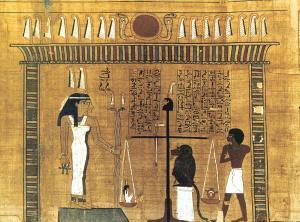
The Two Truths in the Judgment Hall weigh the heart of the deceased against Truth, Ma’at.
Isis has always been considered a wise Goddess. A Turin papyrus tells us, “Isis was a woman wise in speech, her heart more cunning than the millions of men, her utterance was more excellent than the millions of gods, she was more perceptive than millions of glorified spirits. She was not ignorant of anything in heaven or earth.” In this aspect, Isis is called Rekhiet, “the Wise Woman.” One of the titles of Isis of the star, Isis-Sothis, is Rekhit, “Knowledge.” This easily led to Isis’ later identification with Sophia (Gk. “Wisdom”). From his Egyptian studies, Plutarch concluded that Isis is a Goddess “exceptionally wise and a lover of wisdom.”
As time passed, Isis’ reputation as a Goddess of Truth, Rightness, Justice, Wisdom, and Law incresed. The hymns to Isis at Her temple in the Faiyum oasis say that Isis, “taught customs that justice might in some measure prevail” and that She is “a judge with the immortal gods.” The hymn’s author, Isidorus, write to his Goddess, “You are directing the world of men, looking down on the manifold deeds of the wicked and gazing down on those of the just” and “You witness individual virtue.” Like Demeter, Isis was called Thesmophoros, “Lawgiver.” A number of Greek inscriptions from Delos and one from Athens calls Her Dikaiosyne, “Righteousness” or “Lawfulness.” Others call Her Nemesis, a Greek justice-bringing Goddess. The ancient historian, Diodorus Siculus, records that “Isis also established laws, they say, in accordance with which the people regularly dispense justice to one another and are led to refrain, through fear of punishment, from illegal violence and insolence…”
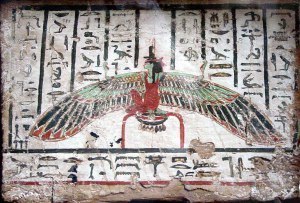
Green Isis, looking like Ma’at, but you can identify Her by the throne on Her head, though the black paint is partially flaked off.
In almost all of the surviving Isis aretalogies (self-statements), the Goddess affirms Her connection with Ma’at. In the aretalogy from Kyme, Turkey, Isis says of Herself, “I made the right to be stronger than gold or silver. I ordained that the true should be thought good. I devised marriage contracts. I ordained that nothing should be more feared than an oath. I have delivered the plotter of evil against other men into the hands of the one he plotted against. I established penalties for those who practice injustice. I decreed mercy to suppliants. I protect righteous guards. With me the right prevails.” Similar statements are included in other aretalogies including one from Maronea in Greece, which says that Isis “established justice, so that each one of us, just as he by nature endures equal death, may also be able to live in conditions of equality.” In the late Hermetic texts, both Isis an Osiris are known as lawgivers. One such text, the Kore Kosmou, tells us that Isis and Osiris learned the secrets of lawgiving from God and so became lawgivers for humankind.
The words of the Lady of Words of Power are not only words of magic, but also words of Truth and Justice.
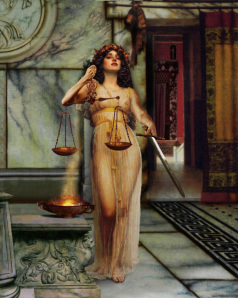
Justitia, by Howard David Johnson
P.S. What inspired me for this post was an interesting article by Christopher Faraone and Emily Teeter that opines that the Greek Wisdom Goddess Metis (Who Zeus married then ate (!!!) because He can be a rather jealous God and Metis was destined to bear Him a daughter (again, !!!) Who would be as powerful as Zeus and as wise as Metis, and a son Who would be king of the Gods, and Zeus couldn’t have that) was either directly or indirectly derived from the Egyptian Goddess Ma’at. They argue that 1.) both Metis and Ma’at were understood as concepts and personified Goddesses; 2.) The fact of Zeus “gulping down” Metis may derive from the Egyptian idea that the Deities “lived on” and “ate” Truth (Ma’at); 3.) Both Metis and Ma’at legitimate the kingship; 4.) Just as Egyptian kings had Ma’at names among their coronation names, so Zeus has a number of epithets that include Metis. Interesting, isn’t it?
Filed under: Goddess Isis Tagged: Aspects of Isis, Egyptian judgment after death, Goddess, Goddess Isis, Goddess of Truth, Goddess of Wisdom, Hall of the Two Truths, Isis, Isis & Hathor, Isis & Wisdom, Isis and Ma'at, Isis Magic, Isis the Wise, Lady of Truth, Maat








March 29, 2014
Isis the Alchemist
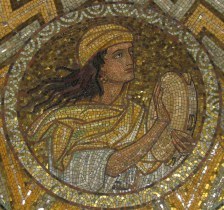
The Hebrew prophetess, Miriam; from the Dormition Church in Jerusalem; photo by Deror Avi
Like Her fellow Magician God, Hermes Trismegistos (aka Thoth), the Goddess Isis is associated with early alchemy. In an alchemical text with the lengthy title The True Book of Sophe the Egyptian and of the God of the Hebrews, Lord of the Powers, Sabaoth, we learn of a particular alchemical method called the Tincture of Isis. Why are Isis and Her tincture mentioned in a book “of the God of Hebrews”?
Perhaps it has to do with another famous alchemical text in which Isis plays the leading role and which seems to have a particularly Old Testament ring to it. The text is called Isis the Prophetess to Her Son Horos. We have only two fragmentary versions of the text. One comes from the 11th-century-CE Codex Marcianus, which was a collection of ancient texts and bits of texts. See if this story doesn’t sound a bit familiar…
The story of Isis the Prophetess
Horus sets out to battle Typhon and Isis goes to the city of Hormanouthi (“Place of Horus;” probably Edfu) “where the Sacred Art of Egypt is practiced in secret.” She stays there a while, but as She is leaving, an angel catches sight of Her and wants to have sex with Her.
“Not until you tell me of the preparation of gold and silver,” says canny Isis.
Highly disappointed, the angel says he can’t reveal that information as it is such a Great Mystery, but that a higher angel, Amnael, would come the next day and be able to answer the question.
Next day, Amnael comes. He showed Isis a “certain sign” he had on his head as well as a vase not coated with pitch and filled with transparent water that he held in his hands, but he wouldn’t give Her the secret.
Apparently, Amnael, “first prophet and angel among them,” is also taken with lust for the Goddess and the two go back and forth on that topic for a couple of days until Amnael can’t stand it anymore and agrees to reveal the alchemical secrets to Isis.
First He has Her swear a mighty oath by “fire and water, light and darkness, by fire, water, air, and earth,” and by a variety of Greek and Egyptian Deities. She so swears and promises that She would not reveal the secrets to anyone but Horus.

“Ask him what he has sown and what he has harvested.”
And here is the great secret. Ready? “So go then, my child, to a certain laborer named Achaab, and ask him what he has sown and what he has harvested, and you will learn from him that the man who sows wheat also harvests wheat, and the man who sows barley also harvests barley.” “For a nature rejoices another nature, and a nature conquers another nature.”
So now you know the Mystery. (Not too exciting on the face of it, is it?) What we don’t know from the fragments left to us is whether Isis ever actually had to give it up for this information or whether She just wore the angel down with Her consistent refusals and constant questions. Perhaps after all that revelation of mysteries, the angel was no longer in the mood.
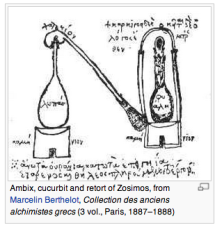 You might have recognized in this tale echoes of the old “randy angels” story of Enoch. The sons of heaven desired the daughters of men. After they mated with them, the angels taught the women all the crafts, which was “forbidden,” though very useful, knowledge. It’s another damned Eve story. Sigh. Woman does what she has to in order to get the information everybody needs—knowledge of good and evil; knowledge of crafts—but then she gets reviled for it. Happily, we don’t see that happen in the Isis the Prophetess story. Apparently, Isis passes this vital alchemical secret down to Horus, and to Her other alchemical sons and daughters (yes, women were alchemists, too). This story should also remind us of the story of Isis & Re in which Isis uses a trick to gain vital knowledge from the Sun God—the knowledge of His powerful, magical name—and which She again passes to Her child.
You might have recognized in this tale echoes of the old “randy angels” story of Enoch. The sons of heaven desired the daughters of men. After they mated with them, the angels taught the women all the crafts, which was “forbidden,” though very useful, knowledge. It’s another damned Eve story. Sigh. Woman does what she has to in order to get the information everybody needs—knowledge of good and evil; knowledge of crafts—but then she gets reviled for it. Happily, we don’t see that happen in the Isis the Prophetess story. Apparently, Isis passes this vital alchemical secret down to Horus, and to Her other alchemical sons and daughters (yes, women were alchemists, too). This story should also remind us of the story of Isis & Re in which Isis uses a trick to gain vital knowledge from the Sun God—the knowledge of His powerful, magical name—and which She again passes to Her child.
Umm, the Tincture of Isis?
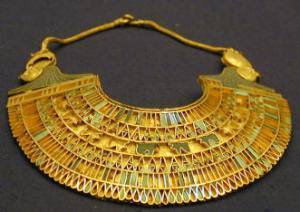
Made with “the tincture of Isis”?
So the story gives us the connection between Isis and Hebrew tradition, but what is the Tincture of Isis? The great Mystery revealed by the angel means something like “you reap what you sow” or “you’ve got to spend money to make money.” It refers to the method of alloying a small amount of gold with another metal to make a greater amount of gold. We still do this. 24-karat gold is 99.9% gold. But 14-karat gold is only slightly over half gold. 14 karat and even 10 karat are common for jewelry. The Tincture of Isis was this secret….that you can alloy gold with other metals and still produce perfectly serviceable gold.
This story about Isis the Prophetess is attributed to Zosimos, a famous Egyptian alchemist of the 3rd century CE. He wrote that in Egypt, the methods of working metal and alchemy were a carefully guarded royal and priestly secret and that it was illegal to publish anything on the subject. This could mean that there truly was an ancient and secret Egyptian tradition of the transmutation of metals. Zosimos also tells us that Isis’ temple at Memphis had alchemical inscriptions. He writes, “At the eastern entry of Isis’ temple, you’ll see characters dealing with the white substance [silver]; at the western entry, you’ll find the yellow mineral [gold] near the orifice of the Three Springs.”
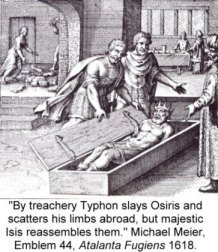
That’s Isis way in the back of this picture, picking up after Osiris.
Isis’ connection with alchemy only grew with time. As we follow Her into the world of Renaissance and post-Renaissance Europe, Isis, the Lady of Many Names, appears to us under a variety of guises appropriate for a Goddess of Alchemy. She is the Virgin of the World Who bears the alchemical Child of the Sun and the Moon. She is understood as Luna, the Moon and the Ruler of its Powers. She is Nature, or Physis Whose ways the alchemists strive to emulate. She is the alchemical Queen and Bride Who weds the Solar King. She is the Anima Mundi, the Soul of the World, the spirit of life itself. She is Sophia, the Lady of Wisdom both Divine and Natural. And She is the Lady Venus, the Veiled Goddess of the Rosicrucians, Who is revealed only to true initiates.
For alchemists, the myth of Isis and Osiris was a myth of the alchemical process. The theme of dismemberment and reassembly was a mythic statement of the alchemical motto: solve et coagula— dissolve and re-join; while the birth of the Divine Child from parents identified with the Moon and Sun, as Isis and Osiris had long been, could not have been more alchemical.

In the 5th Hour of the Amduat, the central mound, surmounted by the head of Isis, serves as a sort of alchemical retort for the transformation and rebirth of Osiris-Re. Isis is said to fill the cavern with fire from Her mouth. And the water beneath the figures is both Water and Fire. All very alchemical, isn’t it? And in a land where it was all about transformation and rebirth, it certainly makes sense.
Filed under: Goddess Isis Tagged: Alchemy, Ancient Egypt, Aspects of Isis, Goddess, Goddess Isis, Isis, Isis & alchemy, Isis Magic, Isis the prophetess, Osiris








March 22, 2014
The Isiac Rites of Spring
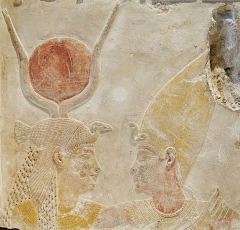
Spring equinox is for lovers
Happy spring! Whether you are still digging out from the snow or are, like lucky me, going to enjoy a warm(ish) and sunny equinoctial weekend, still the light is returning and the everything is rousing itself to shake off winter’s grip. Ahh.
As this is the post-equinox weekend, I have a number magical obligations to attend to, so it’s re-run time. Here’s a slightly revised post from last spring. And it’s about sex. Again. Because, well, spring.
In his essay on Isis and Osiris, Plutarch mentions an Egyptian festival that he says marked the beginning of spring and which was called The Entry of Osiris into the Moon. Here’s what he says:
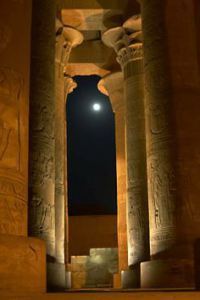
Temple by full moonlight
“Further, on the first day of the month of Phamenoth they hold a festival, which they call Entry of Osiris into the Moon, for it is the beginning of spring. Thus they locate the power of Osiris in the moon and say that Isis, as the creative principle, has intercourse with him. For this reason they also call the moon the mother of the world and they believe her nature to be both male and female since she is filled and made pregnant by the sun while she herself in turn projects and disseminates procreative elements in the air.” (Plutarch, On Isis and Osiris, 43)
In his discussion of this passage, J. Gwyn Griffiths (have I mentioned he’s one of my favorite Egyptologists?) notes that there is no festival by that name in any known Egyptian calendar.
Then he goes on to discuss some Egyptian texts from the temple at Denderah that show Osiris in a boat with Isis and Nephthys and explain that Osiris is entering into the Left Eye; and the Left Eye, as you may know, is an Egyptian designation for the moon. Osiris is said to enter on the 15th of the month, which would be at the full moon. Spring is not mentioned in the Denderah texts, but the Egyptians definitely celebrated the full moon.
Griffiths suggests that Osiris is here considered a solar Deity; the sun “entering into” the moon. At full moon, moon and sun are in opposition and it is only in this position that moon can be fully revealed, so in opposition, the sun could be said to “enter into” the moon, fully illuminating it. And Osiris can have solar aspects as when He is the Sun at Midnight in the otherworld.
We don’t know where Plutarch got his information about the Entry of Osiris into the Moon. But it would have been natural to him to think in terms of a masculine sun uniting with a feminine moon. Not only were those the commonly assigned solar and lunar genders in the Greek world, but by his time in the broader Mediterranean world, Isis was associated with the moon—along with all Her other cosmic connections.
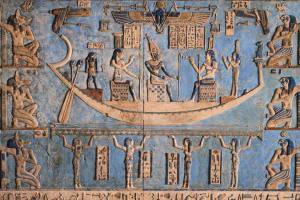
Osiris in the moon boat with Isis and Nephthys from Denderah; I’m not sure this is the one Griffiths is describing, but it’s got to be close
But for the Egyptians, the moon was masculine so I’m not sure Osiris must be considered solar in this case. Perhaps He is intended to be the lunar Deity He could be in Egyptian tradition. At the full moon, He is fully reassembled and whole, the 14 days leading up to the full moon symbolizing the 14 pieces of His body that Isis found and united for His renewal.
So Osiris, reassembled and whole, enters into the moon and Isis, the Creative Principle, unites with Him in sexual intercourse. Now the moon is both male and female for the God and Goddess are united in sexual embrace in it. The fertility bringing moon is ultra-complete not only because the God is fully reassembled, but because He is also united with the Goddess. The masculine-feminine moon becomes the Mother of the World. Like everyone else, the Egyptians connected the moon with fertility and preferred to plant seeds at the full moon, that is, at the height of its fertile power.
To date, this is all I know about this ever-so-intriguing reference. Maybe there was a special full moon celebration at the first full moon in spring. Whatever the case, I very much like the idea of a spring sexual rite of Isis and Osiris and, in fact, this reference inspired the rite of sacred sexuality called (not surprisingly) The Entry of Osiris into the Moon in Isis Magic, which takes a whole weekend and should leave you…well satisfied.
Happy spring equinox…and may Isis and Osiris inspire and bless you in this season of growing light and life.
Filed under: Goddess Isis, Modern Paganism Tagged: Full Moon, Goddess Isis, Isis, Isis & Osiris, Isis Magic, Isis Moon, Moon mysteries, Osiris Moon, Rites of Isis, Rites of Spring, Spring sacred sexuality








March 15, 2014
The Magic of the Hair of Isis
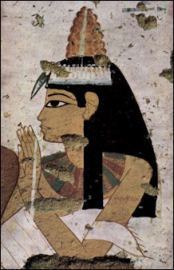
The charm of beautiful hair
We are not immune to the charms of a beautiful head of hair and the ancient Egyptians weren’t either.
But they took appreciation for hair, especially feminine hair, to a whole new level of magnitude. For them, hair was magical. And, of course, Who would have the most magical hair of all? The Goddess of Magic: Isis Herself.
I have always understood that the long hair of Isis in Egyptian tradition—disarrayed and covering Her face in mourning or falling in heavy, dark locks over Her shoulders—to be the predecessor of the famous Veil of Isis of later tradition. Ah, but there is so much more.
In ancient Egypt, it was a mourning custom for Egyptian women to dishevel their hair. They wore it long and unkempt, letting it fall across their tear-stained faces, blinding them in sympathy with the blindness first experienced by the dead. As the Ultimate Divine Mourner, this was particularly true of Isis. At Koptos, where Isis was notably worshipped as a Mourning Goddess, a healing prayer made “near the hair at Koptos” is recorded. Scholars consider this a reference to Mourning Isis with Her disheveled and powerfully magical hair.
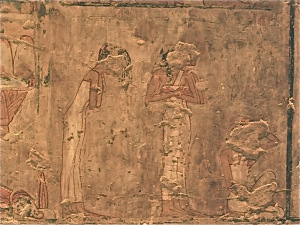
Mourners use various mourning gestures and dishevel their hair
It is in Her disheveled, mourning state, that Isis finally finds Osiris. She reassembles Him, fans life into Him, and makes love with Him. As She mounts His prone form, Her long hair falls over Their faces, concealing Them like a veil and providing at least some perceived privacy for Their final lovemaking. As the Goddess and God make love, the meaning of Isis’ hair turns from death to life. It becomes sexy—remember those big-haired “paddle doll” fertility symbols?
This pairing of love and death is both natural and eternal. How many stories have you heard—or perhaps you have a personal one—about couples making love after a funeral? It’s so common that it’s cliché. But it makes perfect sense: in the face of death, we human beings must affirm life. We do so through the mutual pleasure of sex and, for heterosexual couples, the possibility of engendering new life that sex provides.

Isis, in kite form, covers and makes love with Osiris
The lovemaking of Isis and Osiris is the ultimate expression of this. Chapter 17 of the Book of Coming Forth by Day (aka the Book of the Dead), describes the disheveled hair of Isis when She comes to Osiris:
“I am Isis, you found me when I had my hair disordered over my face, and my crown was disheveled. I have conceived as Isis, I have procreated as Nephthys.” (Chapter 17; translation by Rosa Valdesogo Martín, who has extensively studied the connection of hair to funerary customs in ancient Egypt.)
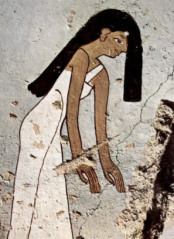
A mourning woman with her hair over her face from the tomb of Minnakht
There is also a variant of this chapter that has Isis apparently straightening up Her “bed head” following lovemaking:
“Isis dispels my bothers (?) [The Allen translation has "Isis does away with my guard; Nephthys puts an end to my troubles.]. My crown is disheveled; Isis has been over her secret, she has stood up and has cleaned her hair.” (Chapter 17 variant, translation by Martín, above.)
This lovemaking of Goddess and God has cosmic implications for its result is a powerful and important new life: Horus. As the new pharaoh, Horus restores order to both kingdom and cosmos following the chaos brought on by the death of the old pharaoh, Osiris.
Not only is hair symbolic of the blindness of death and the new life of lovemaking; the hair of the Goddesses is actually part of the magic of rebirth. Isis and Her sister, Nephthys, are specifically called the Two Long Haired Ones. The long hair of the Goddesses is associated with the knotting, tying, wrapping, weaving, knitting, and general assembling necessary to bring about the great Mystery of rebirth. Hair-like threads of magic are woven about the deceased who has returned to the womb of the Great Mother. The Coffin Texts give the name of part of the sacred boat of the deceased (itself a symbolic womb) as the Braided Tress of Isis.
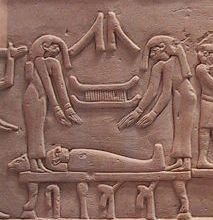
Mourners, probably Isis and Nephthys, throw Their hair over the Osiris
In some Egyptian iconography, we see mourning women, as well as the Goddesses Isis and Nephthys, with hair thrown forward in what is known as the nwn gesture. Sometimes they/They actually pull a lock of hair forward, especially toward the deceased, which is called the nwn m gesture. It may be that this gesture, especially when done by Goddesses, is meant to transfer new life to the deceased, just as Isis’ bed-head hair brought new life to Osiris. It is interesting to note that the Egyptians called vegetation “the hair of the earth” and that bare land was called “bald” land, which simply reiterates the idea of hair is an expression of life.
Spell 562 of the Coffin Texts notes the ability of the hair of Isis and Nephthys to unite things, saying that the hair of the Goddesses is knotted together and that the deceased has come to “be joined to the Two Sisters and be merged in the Two Sisters, for they will never die.”
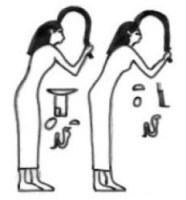
Isis and Nephthys pull a lock of hair toward the deceased
The Pyramid Texts instruct the resurrected dead to loosen their bonds, “for they are not bonds, they are the tresses of Nephthys.” Thus the magical hair of the Goddesses is only an illusory bond. Their hair is not a bond of restraint but rather the bonding agent needed for rebirth. Like the placenta that contains and feeds the child but is no longer necessary when the child is born, the reborn one throws off the tresses of the Goddesses that had previously wrapped her or him in safety.
The Egyptian idea of Isis as the Long-Haired One carried over into Her later Roman cult, too. In Apuleius’ account of the Mysteries of Isis, he describes the Goddess as having long and beautiful hair. Her statues often show Her with long hair, and Her priestesses were known to wear their hair long in honor of their Goddess.
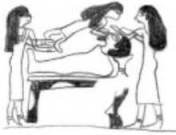
This is sketched from a coffin found in Gebelein (now Naga-el Gheria), 13th dynasty. Either a long-haired female image or a tiny long-haired female person is spreading her hair over the deceased. I must find a photo of this…it is freakin’ amazing!
This little bit of research has inspired me to want experiment with the magic of hair in ritual. In Isis Magic, the binding and unbinding of the hair is part of the “Lamentations of Isis” rite (where it is very powerful, I can tell you from experience), but I want to try using it in some solitary ritual, too. I have longish hair, so that will work, but if you don’t and are, like me, inspired to experiment, try using a veil. It is most certainly in Her tradition. (See “Veil” in my Offering to Isis.)
If you want to learn more about the traditions around hair and death, please visit Rosa Valdesogo Martín’s amazing and extensive site here. That’s where most of these images come from…many of which I had not seen before. Thank you, Rosa!
Filed under: Goddess Isis Tagged: Aspects of Isis, Deities, Egypt, Egyptian magic, Egyptian mourning customs, Goddess, Goddess Isis, Isis, Isis & Nephthys, Isis Magic, Isis Rituals, Isis the Mourner, Lady of Magic, Osiris, The Two Long-Haired Ones








March 8, 2014
Sexuality, Sacred Sexuality & Isis Part 2
A Romano-Egyptian vessel in the form of Isis-Aphrodite
Last time we saw that there is no evidence for temple prostitution in ancient Egypt. Yet we still find writers (usually well-meaning ones discussing sacred sexuality) who tell us that Isis spent ten years as a prostitute in Tyre, that She was beloved by prostitutes, and that Her temples were located near brothels and were reputed to be good places to meet prostitutes.
Where does all that come from?
Well, this is definitely one of those “consider the source” situations.
The bit about prostitution in Tyre is from Epiphanius, a 4th century CE Christian bishop writing against what he sees as heresies. He complains about the sister-brother marriage of Isis and Osiris then launches into the prostitution accusation. There’s no other evidence of this story circulating at the time. He may have made it up. He may have confused Isis with Astarte or even with Simon Magus’ muse Helena, who was a prostitute in Tyre (before being recognized as the Thought of God and the reincarnation of Helen of Troy and rescued by the magician; but that’s a whole other story).
The “tradition” connecting Isis with prostitutes and prostitution comes from a couple of sources; both worthy of clear-eyed consideration (see above). Cyril, Christian bishop of Alexandria in the 5th century CE wrote that “the Egyptians,” especially the women (!!!), when they were made initiates of the religion of Isis “are deemed worthy of honor—therefore of wantonness.” (On Adoration in Spirit and Truth, 9) But before him, a number of Roman poets and satirists made such claims in relation to devotion to Isis. Her temples were supposed to be great places to meet loose women. And then there was the famous Isiac scandal, told by the Jewish historian Josephus, in which a Roman matron was supposedly tricked into going to the Temple of Isis so that “Anubis” could sleep with her.
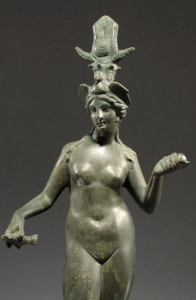
Isis-Aphrodite, a Roman bronze from the 1st or 2nd century CE
When you look more closely into these accusations and put them in context, you see that the poets complained not only of temples of Isis, but of anywhere in Rome where women either gathered (the temples of a wide variety of Goddesses as well as just about any public space, for instance) or went to protect their interests (such as courts of law). If women are allowed to run around loose, lewdness is sure to follow. It’s pure misogyny, folks. (One of these poets, the appropriately named Juvenal, wrote a poem called Against Women, in case I have not already made myself sufficiently clear.)
Without seeing the irony, several of these poets would write about sexual immorality and the temples of Isis, then turn around and complain when their mistresses would abstain from sex for a period of ten days as part of their devotion to Isis. (This period of abstention was known as the Castimonium Isidis or “Chastity of Isis.” Surely it was intended as a purification prior to some important Isiac rite.)
In fact, we have far more evidence for morality and chastity among Roman Isiacs than we do for sexual promiscuity. I’m sure it happened. Humans. Sex. But it wasn’t part of the temple proceedings.
So now we know. But that was Rome, and rather late. What about Egypt?
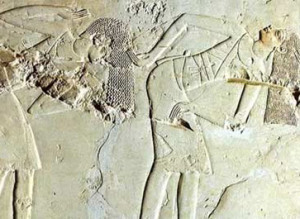
Ecstatic dance for Hathor
We know there were exuberant religious celebrations that included drinking and dancing in Egypt. In the 5th century CE, Herodotus notes a celebration for Bastet in which boats full of men and women traveled to Bubastis, laughing, singing, clapping, rattling (sistra?) and playing flutes, the women hurling ritual abuse at other women along the riverbank and some raising their skirts to expose themselves to the crowd. The historian notes that more wine was drunk during that festival than all the rest of the year. You know there was some drunken sex going on. Surely this was a festival meant to inspire fertility in the land and in the people. I’ll bet it did, too. Festivals of drunkenness were also celebrated for Hathor. And a recently discovered and translated papyrus, dating back 1900 years, appears to be a fictional story about a devotee of Mut who seduces someone into joining the sexy, drunken festivities for the Goddess.
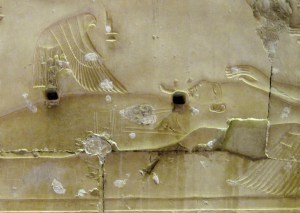
Isis as the kite settled on the phallus of Osiris, from Abydos
I’m not aware of a festival of drunkenness for Isis. The emotionalism associated with Her cult is the sorrow of lamentation—and eventually the joy of reunion with the Beloved. But there is good reason to think of Isis and sex. After all, She is one of the Deities to Whom one prayed for children; and naturally, one must take physical-world action along with one’s prayers. Furthermore, the story of Isis and Osiris has at its heart a sexual coupling. The Goddess magically resurrects Her husband in order that They may make love one last time and so conceive Their child, Horus.
A very unusual 2002 find at Osiris’ temple at Abydos may provide some information. It appears to be a votive offering and shows a woman and man having intercourse. Unlike most Egyptian representations of sex, it is neither crude nor satirical. The man is particularly well endowed, and in contrast to most male-female depictions, the woman is shown larger than the man. Because of the fragmentary nature of the carving, we can’t be sure what sexual position is intended, but it may be that she is straddling him. If so, then perhaps this is because she is intended to be in the Isis (or Nuet) position of woman-on-top.

A clearer picture of the same; Isis comes to make love and bring life to Osiris
Best guess is that it was a votive offering to promote fertility, even though such offerings were usually in the form of a phallus or a “fertility figure” (such as one of the big-haired wasp-waisted “paddle” dolls). The archeologists studying the votive have suggested that there might have also been an Isis shrine in the Osiris temple (which seems likely) and thus the sexual votive would be even more appropriate. Sex is crucial to Isis and Osiris as well as to the Egyptian dead. Sex is part of the magic of renewal and rebirth. It is the magic Isis works with Osiris. It is the magic the Goddess in Her many names works for the dead. (See my post on Isis as a sexy Goddess here.)
In the early days of my relationship with Isis, one of the things She asked of me was that my lovemaking be given in Her name. Now, it could be that the researchers’ guess is correct and that the votive was an offering made to ask for fertility. But perhaps this unusual and somehow poignant votive offering was an expression of the same sort of thing that Isis asked of me so long ago. Perhaps it is a reminder that lovemaking is sacred, that it is a vital part of Isis’ magic of renewal, and that we should honor it as She does.
Filed under: Goddess Isis Tagged: Abydos, Aspects of Isis, Cyril of Alexandria, Egyptian magic, Epiphanius, Goddess, Goddess Isis, Goddess worship, Isis, Isis & Hathor, Isis and sexuality, Isis Magic, Isis the Magician, Isis-Aphrodite, Juvenal, Osiris, Votive offering








March 1, 2014
Sexuality, Sacred Sexuality & Isis; Part I
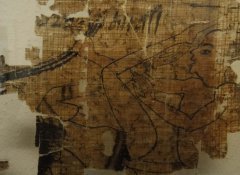
Egyptians…having sex!
After being such high-minded priestesses and priests for the past 5 weeks, it’s definitely time to talk about sex.
If you’ve ever looked into the topic of ancient Egyptian sexuality, you’ll know that they were pretty comfortable with sexuality. Sex was part of the great cycle of creation, life, death, and rebirth. You’ve no doubt read some of the famous ancient Egyptian love poetry with passionate lines like these:
“Your love has penetrated all within me, like honey plunged into water.” “To hear your voice is pomegranate wine to me—I draw life from hearing it.” As well as some that are an appreciation of the sheer physical beauty of the beloved:
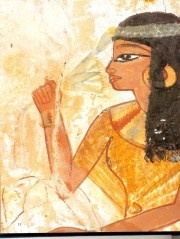
Yes, of course the lotus was a symbol of sexuality!
“Sister without rival, most beautiful of all, she looks like the star-goddess, rising at the start of the good New Year. Perfect and bright, shining skin, seductive in her eyes when she glances, sweet in her lips when she speaks, and never a word too many. Slender neck, shining body, her hair is true lapis, her arm gathers gold, her fingers are like lotus flowers, ample behind, tight waist, her thighs extend her beauty, shapely in stride when she steps on the earth.”
We have such poetic passion from the perspective of both the woman and the man. Before marriage, young men and women seem to have had freedom in their love affairs. After marriage, fidelity was expected, though it went much worse for the woman—including death—if she was caught in infidelity. The ancient Egyptians present a puzzling picture when it comes to homosexuality. On one hand, we have copies of the negative confession in which the (male) deceased declares that he has not had sex with a boy. The only reference to lesbianism comes from a dream-interpretation book in which it is bad omen for a woman to dream of being with another woman. And most references to man-on-man sex refer to the rape to which a victor may subject the vanquished enemy.
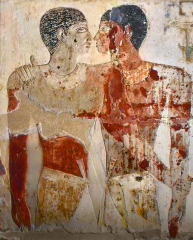
Royal servants and confidents of the king…and most likely, a gay couple.
And yet we have two instances of a consensual homosexual relationship that seem to be okay: King Neferkare goes off with his general and it is implied that they do so for sex. We also have the tomb of what used to be called The Two Brothers. More modern researchers have suggested that the men, who were royal servants and confidents, were a gay couple. This is based on their tomb paintings, which show them embracing each other or in placements usually reserved for a husband and wife. The men are shown with their children, but their wives, the mothers of the children, are very de-emphasized, almost to the point of being erased.
Yet I want to talk not about ancient Egyptian sexuality in general, but about sexuality and religion, and especially sexuality in relation to Isis.
Temple Prostitution? Nope.
First, let us put the whole “temple prostitutes” thing right out of our heads when it comes to Egypt. There is no evidence of the practice in Egypt. Yes, I know. It was very exciting for the old gentlemen to contemplate the ever-so-Pagan goings on in those richly colored temples in days of old. But it may not have been quite how the old gentlemen envisioned it. (Please see my kindly rant on the old gentlemen of Egyptology here.) In fact, the one specific reference comes from the Greek geographer and historian Strabo (64 or 63 BCE-24 CE). Here’s the passage in its Loeb 1930s translation:
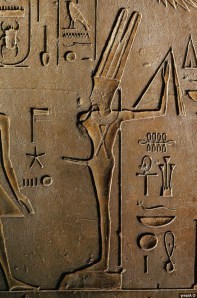
Min was associated with Isis at Koptos
“…but to Zeus, whom they hold highest in honour, they dedicate a maiden of greatest beauty and most illustrious family (such maidens are called “pallades” by the Greeks); and she prostitutes [or "concubines," pallakeue] herself, and cohabits [or "has sex" synestin] with whatever men she wishes until the natural cleansing of her body takes place; and after her cleansing she is given in marriage to a man; but before she is married, after the time of her prostitution, a rite of mourning is celebrated for her.” (Strabo, Geographies, 17.1.46)
Well, it’s right there, ain’t it? But let’s take another look. The keys are the Greek word pallades that Strabo says the Greeks called such maidens, its relation to another Greek word, pallakê, and how it was translated, and the old gentlemen who did the original translating.
Pallades means simply “young women” or “maidens.” As in Pallas Athena. Virginity is often implied, but it doesn’t have to be. Pallakê originally meant the same thing; a maiden. However, pallakê had long been translated as “concubine” due to contextual evidence in some non-Egyptian texts. A highly influential scholar of near eastern and biblical texts, William Mitchell Ramsay—one of our old gentlemen, indeed—took the term to mean “sacred prostitute” and so-translated it when he first published these non-Egyptian texts in 1883. He based the translation on his own belief in ancient sacred prostitution and two Strabo passages: one about Black Sea sacred prostitutes and the one about the palladê we’re discussing. Ramsay was so influential that his definition became the reigning one. THE Greek-English dictionary, by Liddell and Scott, had “concubine for ritual purposes” as the first definition of pallakê. Now it is the second one.
[image error]
“Offering to Isis” by Sir Edward john Poynter, 1866; more like our young palladê perhaps?
A non-sexualized translation of the Strabo passage has been made by Stephanie Budin in Prostitutes and Courtesans in the Ancient World, edited by Christopher Farone and Laura McClure. Here it is:
“But for Zeus [Amun], whom they honor most, a most beautiful maiden of most illustrious family serves as priestess, [girls] whom the Greeks call ‘pallades’; and she serves as a handmaiden and accompanies whomever (or attends whatever) she wishes until the natural cleansing of her body; and after her cleansing she is given to a man (or husband); but before she is given, a rite of mourning is celebrated for her after the time of her handmaiden service.”
Sounds quite different, doesn’t it? Would it not be more likely that a highborn girl who has not yet had her period would serve as a handmaiden in the temple, attending whatever rites she wishes—perhaps even getting an education—until she proves herself marriageable by having her first period, rather than expecting an inexperienced girl to immediately start having sex with “whomever she wishes”? (And who would that be in the temple; the priests who were supposed to abstain from sex during their temple service?) Even the “rite of mourning” is explicable as a kind of farewell to childhood that the young woman would celebrate with her fellow handmaidens and priestesses as she left the temple to take up her married life.
Besides, sex in an Egyptian temple was taboo. Even Herodotus knew of the prohibition against sex in Egyptian temples when he says that the Egyptians were the first to make it a matter of religion not to have sex in temples and to wash after having sex and before entering a temple. (Histories, 2.64)
Alternatively, Budin wonders whether Strabo might have been hearing stories about the Divine Adoratrice or God’s Wife of Amun, powerful and high-ranking priestesses of the centuries before Strabo’s visit. But at least in the later dynasties, these priestesses were celibate and tended to rule long past their first menstrual period.
Sacred Sexuality? Yep.
Well, I didn’t know I was going on so much of a tear today. It seems I have used up all of today’s time and space—and probably your patience—and haven’t even gotten to Isis yet. So we’ll do that next time with more on sexuality in Egyptian religion…and we will indeed get to Isis.
Filed under: Goddess Isis Tagged: Ancient Egypt, Deities, Egypt, Egyptian love poetry, Egyptian sexuality, Egyptian Temples, Goddess, Goddess Isis, Herodotus, Homosexuality in ancient Egypt, Isis, Isis Magic, Isis Rituals, Pagan Spirituality, Priestess and Priest of Isis, priestess of Isis, Sacred sexuality, Sexuality, Sexuality and Isis, Stephanie Budin, Strabo, Who is Isis?








February 22, 2014
What does it mean to be a priestess or priest of Isis? Key 5: Spiritual Growth
 Finally, we come to the heart of the personal work of the priestess or priest of Isis. It is the last of the keys to priest/esshood we’ll talk about: the work of spiritual development.
Finally, we come to the heart of the personal work of the priestess or priest of Isis. It is the last of the keys to priest/esshood we’ll talk about: the work of spiritual development.
Spiritual growth or development is a process, not an end result. It is the ongoing search for and discovery of the truth of our hearts and souls, our Selves, and our relationship with the Divine.
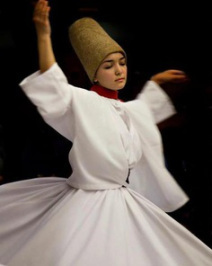 It is not a single truth nor is it an unchanging truth. The process of growth is, after all, a process of change. It is not a truth contained in the pages of just one book—though Paths to it may be found in many books, written in many different languages. It is a truth most convincingly found in our own experience of the Divine by whatever Name we call It and in whatever form we imagine It. This truth calls us from the core of our Being. It is the truth against which our hearts will be weighed on the Scales of Truth when we pass from this world into the next.
It is not a single truth nor is it an unchanging truth. The process of growth is, after all, a process of change. It is not a truth contained in the pages of just one book—though Paths to it may be found in many books, written in many different languages. It is a truth most convincingly found in our own experience of the Divine by whatever Name we call It and in whatever form we imagine It. This truth calls us from the core of our Being. It is the truth against which our hearts will be weighed on the Scales of Truth when we pass from this world into the next.
Spiritual growth is the process of discovering our personal truth and learning how that truth is in (or can be brought into) harmony with the Divine, eternal truth. Once discovered, this gnosis—this deep, sacred knowing—can serve us as a guide for creating ways to live life more authentically and with more wisdom and compassion.
 Our entire relationship with Isis is part of this process. Anything and everything we do in relation to Her, from making offering to deep communion, helps this process. Each and every time we make contact with our Goddess, we can increase our harmony with Her. We are like the strings of a musical instrument that begin to vibrate when the bow is drawn across any one of them. The ancient theurgists would have considered such Divine contact to help “purify” us, that is, to help us connect more clearly with our pure or essential natures.
Our entire relationship with Isis is part of this process. Anything and everything we do in relation to Her, from making offering to deep communion, helps this process. Each and every time we make contact with our Goddess, we can increase our harmony with Her. We are like the strings of a musical instrument that begin to vibrate when the bow is drawn across any one of them. The ancient theurgists would have considered such Divine contact to help “purify” us, that is, to help us connect more clearly with our pure or essential natures.
All of the exercises, rituals, and meditations that make up the stages of relationship with Isis in Isis Magic are designed to help us do this. One of the key tools for growth, the “Invocation of the Shining One,” first makes its appearance at the stage of relationship called the Magician of Isis.
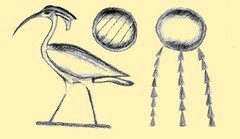
Hieroglyphs for the Akh
Like Isis Herself, the Shining One has been called by many names. In ancient Egypt, it would have been the Akh or Aakhu, meaning both “shining” and “effective” one. It has also been called the Higher Self, the Deep Self, the True Self, the God/dess Self, the Genius, the Atman, the Augoeides, the Holy Guardian Angel, and the Isis Within. It is that greater part of each one of us which is essentially Divine. Contact with this Divine Self is critical to our spiritual development.
Many people find they have difficulty with this aspect of the spiritual journey. I know I did and do. It is genuinely difficult work, yet it is vital. Only patience and persistence will see us through. Simply return again and again to the work of making contact with and experiencing the Shining One, the Isis Within.
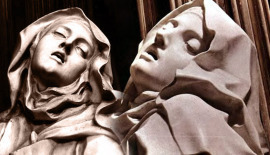
St. Teresa in ecstasy
This work is hard to talk or write about because it becomes very personal and individual. For insight, there are numerous books you can explore. Look for works on enlightenment; Hindu, Buddhist, Christian, Pagan.
The work of spiritual growth will make us weep. Many times. It will also make us laugh with unexpected joy. We will catch a glimpse of the Isis Within. And then we will go on with our lives.
 For spiritual growth does not mean there will be no more trouble in our lives. It does not insulate us from trouble or pain. No matter how spiritually developed we may be, we and the people in our lives are still human, capable of all the beauty and ugliness of humanity.
For spiritual growth does not mean there will be no more trouble in our lives. It does not insulate us from trouble or pain. No matter how spiritually developed we may be, we and the people in our lives are still human, capable of all the beauty and ugliness of humanity.
What spiritual development does mean is that we will be able to cope with our day-to-day duties and the trials we encounter in our lives in a much wiser and more compassionate manner. We will be better able to understand—and thus shape—our thoughts and actions so that they are better aligned with our growing gnosis. We will find ourselves less tossed about by our emotions, more able to see the beauty in life. We will become more open, less defensive.
 In our relationship with Isis, we experience the sacred. We grow. We discover who we really are. We become wiser and more compassionate. We learn how to live more authentically, in greater harmony with our true selves and the Divine reality of the Goddess. It is, perhaps, the most vital aspect of serving the Goddess as Her priestess or priest. If we have done it well, we will become better people.
In our relationship with Isis, we experience the sacred. We grow. We discover who we really are. We become wiser and more compassionate. We learn how to live more authentically, in greater harmony with our true selves and the Divine reality of the Goddess. It is, perhaps, the most vital aspect of serving the Goddess as Her priestess or priest. If we have done it well, we will become better people.
Filed under: Goddess Isis, Modern Paganism Tagged: Goddess, Goddess Isis, Goddess worship, Isis, Isis & Spiritual Growth, Isis Magic, Isis Rituals, Isis worship today, Lady of Magic, Pagan Spirituality, Priestess and Priest of Isis, The meaning of Priest/esshood today, what does spiritual growth mean











